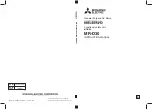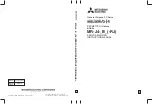
The following connections are possible via the Ethernet interface:
Connections
Description
Point-to-point connection
The device is connected directly to the PC via an
Ethernet cable.
Network connection
The device is connected to an Ethernet network.
Tab. 27: Options for connection
The device supports the following methods of IP configuration (based on IPv4):
Methods
Description
Obtain IP address automatically (DHCP client)
The device obtains its IP configuration from a
DHCP server in your network. This method is
suitable for networks in which a DHCP server
already exists.
Fixed IP configuration
The device uses a fixed IP configuration.
The IP configuration of the device can be perma-
nently assigned manually. However, the device
can only be addressed if the assigned IP configu-
ration matches the IP configuration of the PC.
Factory setting: 192.168.0.1
Tab. 28: Options for IP configuration
7.8.7
[X19], Real-time Ethernet (RTE) port 1 and port 2
The interface [X19] is located on the top of the device. The interface [X19] permits
RTE communication. The following protocols are supported by the interface [X19],
depending on the product design:
Product variant
Supported protocol
CMMT-AS-...-EC
EtherCAT
CMMT-AS-...-EP
EtherNet/IP
CMMT-AS-...-PN
PROFINET
Tab. 29: Supported protocol
The physical level of the interface fulfils the requirements according to IEEE 802.3.
The interface is electrically isolated and intended for use with limited cable
lengths
Tab. 30 Requirements for the connecting cable.
The interface [X19] offers 2 ports.
–
Port 1, labelled on the device with [X19, XF1 IN]
–
Port 2, labelled on the device with [X19, XF2 OUT]
2 LEDs are integrated into each of the two RJ45 bushings. The behaviour of the
LEDs depends on the bus protocol. Use is not always made of both LEDs.
Requirements for the connecting cable
Characteristics
CAT 5, patch cable, double shielded
Max. cable length
30 m
Tab. 30: Requirements for the connecting cable
7.9
Motor connection
7.9.1
[X6A], motor phase connection
The connection [X6A] is located on the front of the device. The following connec-
tions to the motor are established via the connection [X6A]:
–
Motor phases U, V, W
–
PE connection
Incorrect circuitry of PE and motor phases results in a device defect, jerking or
uncontrolled start-up of the motor when the power supply is switched on.
[X6A]
Pin
Function
Description
4
PE
Protective earthing,
motor
3
W
third motor phase
2
V
second motor phase
1
U
first motor phase
Tab. 31: Motor phase connection
The cable shield of the motor cable must be placed on the support surface on the
bottom front of the housing and fastened with the shield clamp.
Requirements for the connecting cable
Wires and shielding
–
4 power wires, shielded
–
Extra optional cables, e.g. for the holding
brake (shielded separately) and the motor
temperature sensor (shielded separately)
Structure
Only use cables that ensure reinforced isolation
between the motor phases and the shielded sig-
nals of the holding brake and motor temperature
sensor in accordance with IEC 61800-5-1.
7.9.4 Shield support of the motor cable
Requirements for the connecting cable
Max. cable length
7.6 Information on EMC-compliant installa-
Max. capacitance
<
250 pF/m
Nominal cross section of power wires
0.75 mm
2
…
1.5 mm
²
Cable diameter of the stripped cable or shield
sleeve (clamping range of the shield clamp)
11 mm
…
15 mm
The only motor cables permitted are those that fulfil the requirements of EN 61800-5-2 Annex D.3.1
and the requirements of EN 60204-1.
Tab. 32: Requirements for the connecting cable
Festo offers prefabricated motor cables as accessories
–
Only use motor cables that have been approved for operation with the Festo
servo drive. Motor cables of other manufacturers are permitted if they meet the
specified requirements.
7.9.2
[X6B], motor auxiliary connection
The connection [X6B] is located on the front of the device. The holding brake
of the motor and the motor temperature sensor can be connected to the connec-
tion [X6B]. The output for the holding brake is used both functionally and in
connection with the safety sub-function Safe brake control
è
Manual Safety
sub-function.
To allow motor temperature monitoring, the following are supported:
–
N/C and N/O contacts
–
KTY 81 … 84 (silicon temperature sensors)
–
PTC (PTC resistor, positive temperature coefficient)
–
NTC (NTC resistor, negative temperature coefficient)
–
Pt1000 (platinum measuring resistor)
The servo drive monitors whether the motor temperature violates an upper or
lower limit. With switching sensors, only the upper limit value can be monitored
(e.g. with a normally closed contact). The limit values and the error response can
be parameterised.
[X6B]
Pin
Function
Description
6
MT–
Motor temperature (neg-
ative potential)
5
MT+
Motor temperature (posi-
tive potential)
4
FE
Functional earth con-
nected to protective
earth
3
BR–
Holding brake (negative
potential)
2
BR+
Holding brake (positive
potential)
1
FE
Functional earth con-
nected to protective
earth
Tab. 33: Motor auxiliary connection
Requirements for the connecting cable
Structure
–
2 wires for the line to the holding brake,
twisted in pairs, separately shielded
–
2 wires for the line to the temperature sensor,
twisted in pairs, separately shielded
Min. conductor cross section including wire end
sleeve with plastic sleeve
0.25 mm
2
Max. conductor cross section including wire end
sleeve with plastic sleeve
0.75 mm
2
Max. length
50 m
1)
1) Take voltage drop into account for cable lengths
>
25 m by selecting suitable cross-sections for the
insulated wires.
Tab. 34: Requirements for the connecting cable
Requirement for the temperature sensor in the motor
–
electrically reinforced isolation from the motor phases in accordance with
IEC 61800-5-1, voltage class C, overvoltage category III.
Shield support requirements
–
Connect the cable shield on both sides.
–
Make unshielded cable ends as short as possible (recommended 120 mm,
max. 200 mm).
7.9.3
Electronic overload and over temperature protection for the motor
The CMMT-AS allows the motor to be electronically protected against overload
and provides over temperature protection with the following protective functions:
Protective func-
tions
Description
Measures required during installa-
tion and commissioning
Temperature moni-
toring of the motor
The motor temperature is
monitored for an upper and
lower limit value, including
hysteresis. The limit values
can be parameterised.
–
Connect the temperature sensor to connec-
tion [X6B] (both switching and analogue
temperature sensors are supported)
–
Parameterise the temperature limit values
in accordance with the type of motor
used, e.g. using the device-specific plug-
in. Comply with the permissible limit
values of the motor.


































